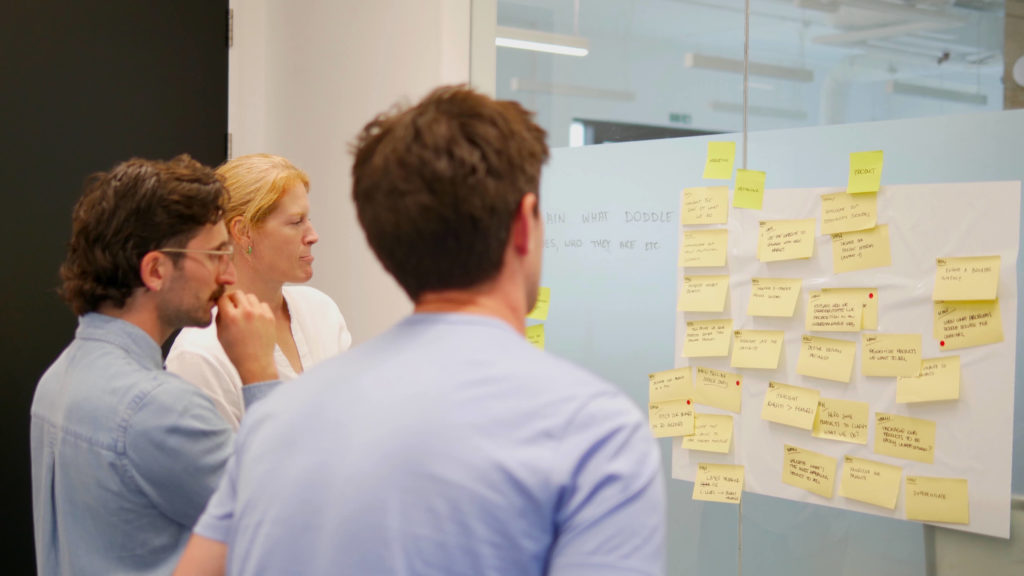
This is me looking intensively at many sticky notes hoping for inspiration.
Facilitation is the most underrated skill in the design world.
Being able to facilitate conversations in meetings and workshops is one of the core skills of a Product Designer. You can apply facilitation techniques to conducting user research and/or user interviews to structure the conversation to understand your users’ problems and needs. The same applies to stakeholders’ meetings when you try to understand their goals and pain points to ensure you create solutions that create value for the business.
As designers, we don’t need to have all the answers, but we can and should create the proper context to extract them.
What do you need to be a good facilitator?
Preparation
One of the best pieces of advice I have been given is to allow time to prepare. If you are running a workshop, you need at least the same time to prepare for it. Is your workshop half a day? Block out half a day in your diary to prep for it.
Aims and objectives
Before you start planning anything at all, make sure you have a clear understanding of why you are running the workshop. This applies to meetings and research too.
Define what you are trying to achieve, and do not confuse the terms aims and objectives. Aims are more long-term, inspirational and high-level. Objectives are more practical and actionable, describing how they allow you to reach your aims.
For example, the aim of the workshop can be to:
- Create a plan for the redesign of the corporate website
The objectives can be something like:
- Identify business goals
- Analyse current customers’ goals and pain points
- Evaluate current website performance
- Prioritise next steps
And check with yourself if the workshop or meeting you are running is the right activity! Nothing is worse than a workshop that leads nowhere or doesn’t add anything to the process. People can tell and disengage when you ask for help next time.
A plan
This is something that I learned when I was a learning designer. For each lesson, teachers create a Scheme of Work. This is a detailed table of how the lesson will be taught and anything you need for each activity. Each activity is also mapped to the aims and objectives that you are trying to achieve. I find this useful as it allows me to give some sense to the creative madness so that I don’t run activities for the sake of it, but they are specific to the objectives we want to achieve.
If you take the previous example, we can say that we decided to run a proto-persona activity for objective #2 so that the group could put themselves in the customers’ shoes and see the pain points for themselves. This is also useful when prioritising to ensure that you have a product that solves customers’ problems.
The workshop
Running a workshop can be stressful. Talking in front of people isn’t easy, and there’s even more pressure when you have a specific goal that you are trying to achieve; you must ensure that you have something concrete to use by the end of the session.
I have run many workshops in the past, and I know firsthand how disappointing it can be when attendees are disengaged or you feel like you haven’t achieved much progress at the end of the workshop.
I've compiled some tips for you to avoid making the same mistake I did and become proficient in running workshops.
First impressions
First impressions are the most important. Over the years, I have learned to introduce myself personally to everyone who joins a face-to-face workshop. Shake their hand, introduce yourself and get to know who they are and what they do. This is a handy way to learn people's names one-to-one.
Engage your audience
Workshops can be pretty strenuous, even if they are just half-day or a few hours, as they can be squeezed between other meetings, and people might find it hard to focus. So you must radiate good energy and keep the session upbeat. Ensure you involve everyone in the conversation or activities you run.
When you are online, it’s much tougher; you can't get a vibe from the room. Therefore, paying attention to everyone on the screen is even more vital. This is why my facilitation style is slightly different for online workshops. I am more direct and to the point. For example, when you ask a question, avoid asking the whole group as it might create awkward silences and direct a question to someone. You can be direct, pleasant and considerate at the same time.
Breaks
This is the obvious one. Take regular breaks, allow people to unwind, get a coffee, go to the loo or do whatever they need to regain energy and stay focused for the rest of the session. It’s even better if you can provide people with plenty of drinks and snacks to ensure they have the energy needed to keep on going.
Did you know our brain is made of over 80% water? So you need to stay hydrated to function!
Keep focussed
Have you ever been in a meeting where someone starts talking about a completely irrelevant subject? And other people get involved, and before you realise it, half of the meeting is gone, and you haven’t covered what the meeting was about. This can be even worse in workshops, and keeping everyone on track can be tricky, especially as you want people to engage. So what can you do to ensure everyone keeps on track?
It’s essential to ensure that people know why they are part of the workshop and what you are trying to achieve by the end of it. For this reason, I usually send a detailed agenda before the session so that we are all on the same page, driving towards the same direction.
Of course, this isn't enough! I also ensure that I cover what the workshop is about at the very beginning by going over the aims and objectives.
This still isn't enough! I create a parking lot activity, an area on the wall or a digital canvas to store all the great ideas that aren’t relevant to the main aims of the workshop. This is extremely valuable to use when someone is derailing the conversation.
However, don’t be afraid to change the planned activities if you feel you are getting value from conversations or other activities. The most important thing is to drive towards the main workshop goal. It doesn’t matter how you get there.
Better to be safe than sorry
This is mainly for digital work, and it is imperative. Ensure all participants are comfortable using the tech stack you need for the workshop. Check if their connection is good enough and if they can use Zoom, Teams, Meet or whatever you will use. Double-check they are ok using a digital canvas and have access to it with no issues. Ask if any participants have access needs you might need to be aware of to ensure everyone can comfortably participate in the workshop. I usually book a 15-minute one-to-one meeting with each participant to run through all of this, and it’s an excellent opportunity to meet them and avoid technical issues that might delay the workshop on the day.
Follow up
Don’t leave people out of the loop after a meeting or a workshop; engage them afterwards when other decisions are made. Colleagues who participated in a workshop invested their time, and it’s essential to show how that benefitted the decision-making process and, therefore, see outcomes from there. If, after the workshop, I create artefacts or conduct usability testing, I share those with the group that took part in the workshop, and I welcome feedback and further conversations if people are interested.
If you are a product designer with excellent facilitation skills, sell it! And use the techniques you have acquired in your career cross-functionally. You can learn by starting small if you aren’t a good facilitator. Facilitate a workshop with your design team first, then invite the whole squad before you engage people from other parts of the organisation and then even clients. Sometimes the best way to learn is by doing it!
